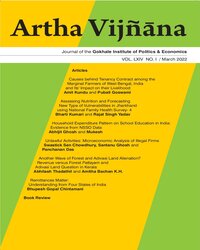Electoral Volatility:Analysis of the States Elections in India (1981-2017)
Subscribe/Renew Journal
In a multi-party democracy, high electoral volatility may emerge from existing economic and political conditions in the country. An ethnically highly diverse society like India, the voting decision is largely based on the number of parties present till the previous year of every election. Small parties result in vote division away from national parties. This paper attempts to establish a relationship between electoral volatility and the variable measuring number of effective parties at every election. It attempts to answer the question – ‘Whether the party fragmentation impacts the volatility?’ Electoral volatility of the people is taken as the dependent variable and the presence of number of effective parties at every election and with a lag of one year to every election as the independent variables. For analysis, State Assembly elections data for 30 Indian states over a period of 37 years from 1981-2017 is undertaken. The analysis supports the hypothesis and we are able to observe a very modest impact of party system on the level of electoral volatility, measured using Pedersen’s Index.
Subscription
Login to verify subscription
User
Font Size
Information



